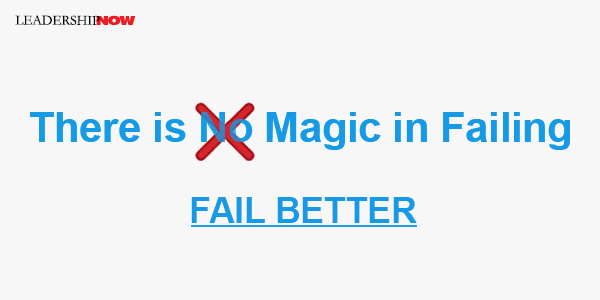 |
 |
01.13.15

There is No Magic in Failing
DESPITE all the talk about making you feel better about inevitable failures, failure is only an opportunity if you learn from it and then act on it. What if you actually orchestrated better failures? Designed useful failures instead of hit or miss failures? That’s what Anjali Sastry and Kara Penn suggest in their book Fail Better. “The right kind of failure instructs, refines, and improves ideas, work products, skills, capacities, and teamwork.” The idea is to “generate small, smart mistakes that enable your team its work requirements (a first-order performance goal) while building capacity, habits, and insight (the second-order, deeper change).”To this end they offer the three-step Fail Better Method: Launch your project. The goal of the launch phase is not to over plan and set things in stone, but to consider your project in context, anticipate outcomes as tied to a series of logical assumptions, pull together your resources, and get the right people involved. Plan your projects in such a way as to make any failures useful. Build and refine. It can be helpful to think of your project as a cauldron for experimentation and learning—in which you will plan, act, and assess to decide the next step. Approach your project in cycles or chunks in which you plan, act, and assess, then take the next step, and even big projects become more tractable while enabling your team to learn and refine its plans. Identify and apply what you've learned. The final step is embedding what you’ve learned not just within your team but organizationally. No one can know exactly why things turn out the way they do. Even while learning from your mistakes, the corrective action is based on incomplete knowledge. You will need to “identify lessons learned while bearing in mind that your understanding is limited.” Learning is a skill that is never taught, but it is a critical one as we go forward. A systems approach is essential. “Systems thinking teaches us that it’s more fruitful to take an endogenous view that seeks to explain how the results are a product of factors in which you play a part as well. You have much more power to shape outcomes if you can better understand how the problems and opportunities you face today are connected to your own past actions and are influenced by the structure of the industry, society, and ecosystem in which you play a role.” Our biggest issues will not be solved with a single solution. Rather they will be solved bit-by-bit—even across groups—one effort at a time. Learning as we go. 
Posted by Michael McKinney at 10:23 PM
|
BUILD YOUR KNOWLEDGE
 

How to Do Your Start-Up Right STRAIGHT TALK FOR START-UPS 
Grow Your Leadership Skills NEW AND UPCOMING LEADERSHIP BOOKS 
Leadership Minute BITE-SIZE CONCEPTS YOU CAN CHEW ON 
Classic Leadership Books BOOKS TO READ BEFORE YOU LEAD |